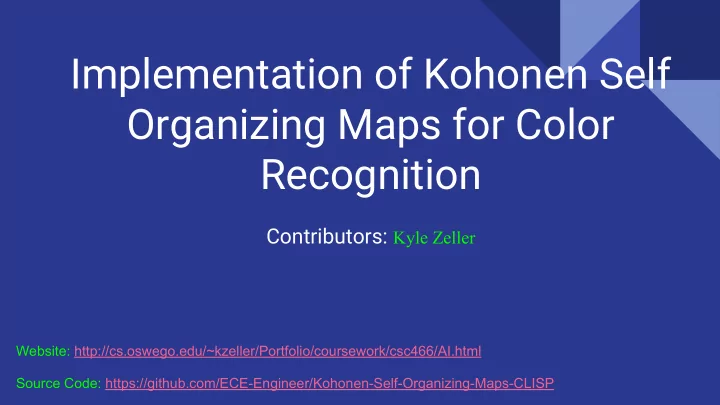

Implementation of Kohonen Self Organizing Maps for Color Recognition Contributors: Kyle Zeller Website: http://cs.oswego.edu/~kzeller/Portfolio/coursework/csc466/AI.html Source Code: https://github.com/ECE-Engineer/Kohonen-Self-Organizing-Maps-CLISP
Main Goal ● Get an accurate description of the RGB vector that you want to be classified by training and labeling the clusters that are formed utilizing Kohonen Self Organizing Maps.
Kohonen Self Organizing Maps “SOMs” ● Kohonen SOMs is an unsupervised machine learning technique discovered by Professor Teuvo Kohonen in the 1980s. ● Kohonen SOMs are generally used for taking n-dimensional information and mapping it down to a 2D representation of the input space ℝ n
Computational Methods ● Euclidean Distance Pearson Correlation Coefficient ● Cosine Similarity ● ● Gaussian Function
Steps
Step 1: Initializing the Map ● Create a random RGB initialization of the map Initialize the map with red, green, blue, blue fading away ● toward the center ● Initialize the map with RGB circles fading away equidistant from the center of the map
Step 2: Finding the Winning RGB Vector ● Given a sample RGB vector, find the most similar RGB vector in the entire map using similarity metrics Use all three similarity metrics for each initialization ● of the map
Step 3: Finding Neighboring RGB Vectors ● Find all the neighboring RGB vectors to the winning vector and within a certain radius, utilizing the gaussian function.
Step 4: The Learning Function ● Scale the winning vector and the neighboring RGB vectors to be more like the sample vector; whereas the further away the neighbors are the less they will learn ○ This utilizes the gaussian function so that everything within a specific radius of the winning RGB vector gets affected
Step 5: Visualizing the grade of the SOM ● Assessing the quality / performance of the program is a common problem with Self Organizing Maps. ● A solution to this is calculating the distance between the RGB vectors and their neighbors; whereas the average of all these distances is a color which is then set to the respective location.
Step 6: Labeling The Clusters ● After the SOMs have been trained, the weighted vectors should be clustered together by their similarities. ● Given this to be the case, craft a way to label all the similar data by asking the program what color is the vector you provide and utilizing secondary clustering (k-means). ● If the system doesn’t already have a classification for the cluster best associated with your vector, supply one to the program to label all the similar vectors in that cluster and to get an accurate color classification.
Step 7: Painting With Clusters ● Take 2 clusters at a time and create a checkerboard out of the RGB vectors in each cluster The secondary clustering plays a large role on the performance of how much ● the colors vary in the clusters
Objective Status & Future Plans ● Objective : “COMPLETE” ● FUTURE PLANS : Utilize Kohonen SOMs on brain imaging using ❏ an EEG; whereas the signals are converted to the RF spectrum using a DFT algorithm. I can try to determine the areas of the brain with the most activity is happening utilizing soms and by creating voxels. Knowing where on the brain the most activity is ❏ can be very useful to finding the ideal places to put the EEG electrodes, which would yield better results when performing research.
Sources ● Shanmugapriya, B., and M. Punithavalli. "A Modified Projected K-Means Clustering Algorithm with Effective Distance Measure." International Journal of Computer Applications 44.8 (2012): 32-36. Web. 4 Apr. 2017. <https://www.researchgate.net/figure/220579196_fig6_Fig-6-k-means-clustering-of-n-dimensional-block-group-vectors-projected -into-SOM>. ● Germano, Thomas E. "Self Organizing Maps." Self-Organizing Maps . N.p., n.d. Web. 04 Apr. 2017. <http://davis.wpi.edu/~matt/courses/soms/index.html#Quality>. ● "Self-organizing maps." Self-organizing maps . N.p., n.d. Web. 04 Apr. 2017. <https://www.viscovery.net/self-organizing-maps>. ● Dozono, Hiroshi. "Application of Self Organizing Maps to Multi Modal Adaptive Authentication System Using Behavior Biometrics." Applications of Self-Organizing Maps (2012): n. pag. Web. 4 Apr. 2017. <https://www.intechopen.com/books/applications-of-self-organizing-maps/application-of-self-organizing-maps-to-multi-modal-ada ptive-authentication-system-using-behavior-bio>. ● Galhardo, Carlos Eduardo Cardoso, and Werickson Fortunato De Carvalho Rocha. "Exploratory analysis of biodiesel/diesel blends by Kohonen neural networks and infrared spectroscopy." Analytical Methods . The Royal Society of Chemistry, 26 Mar. 2015. Web. 04 Apr. 2017. <http://pubs.rsc.org/en/content/articlelanding/2015/ay/c4ay02995j#!divAbstract>. ● "An Introduction to Self-Organizing Maps." University of Manitoba - Information Services and Technology - Personal Homepage Server . N.p., n.d. Web. 04 Apr. 2017. <http://home.cc.umanitoba.ca/~umsidh52/PLNT7690/presentation/SOM.html>. ● Neuro AI . N.p., n.d. Web. 04 Apr. 2017. <http://www.learnartificialneuralnetworks.com/kohonen.html>.
Example
[2]> (start) [11]> (whatis '(128 128 128)) [3]> (whatis '(255 0 0)) "This cluster is unlabeled, please give it a label: " "This cluster is unlabeled, please give it a label: " red gray RED GRAY [4]> (whatis '(0 255 0)) [12]> (whatis '(153 0 0)) "This cluster is unlabeled, please give it a label: " "This vector is RED" green [13]> (whatis '(200 0 0)) GREEN "This vector is RED" [5]> (whatis '(0 0 255)) [14]> (whatis '(100 0 0)) "This cluster is unlabeled, please give it a label: " blue "This vector is RED" BLUE [15]> (whatis '(10 0 0)) [6]> (whatis '(255 255 255)) "This vector is BLACK" "This cluster is unlabeled, please give it a label: " [16]> (whatis '(10 5 15)) white "This vector is BLACK" WHITE [17]> (whatis '(0 200 0)) [7]> (whatis '(0 0 0)) "This vector is GREEN" "This cluster is unlabeled, please give it a label: " [18]> (whatis '(0 150 0)) black "This vector is GREEN" BLACK [19]> (whatis '(0 85 0)) [8]> (whatis '(255 255 0)) "This vector is GREEN" "This cluster is unlabeled, please give it a label: " [20]> (whatis '(0 150 0)) yellow "This vector is GREEN" YELLOW [21]> (whatis '(93 85 127)) [9]> (whatis '(255 122 0)) "This vector is GRAY" "This cluster is unlabeled, please give it a label: " [22]> (whatis '(211 202 255)) orange "This vector is BLACK" ORANGE [10]> (whatis '(255 0 255)) "This cluster is unlabeled, please give it a label: " pink PINK
Questions?
Recommend
More recommend